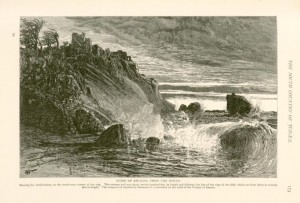
Ruins of Ashkelon, home of the scallion
For an adventure in armchair archaeology, you can do worse than turn to a good dictionary, do a little searching online, or even consult a good atlas. From words in our day-to-day vocabulary to names and places, the ancient past is embedded in language, and sometimes in surprising or humorous ways.
Foods often have names with interesting, early origins. “Steak,†for example is good Old Norse steik, as in steikja, which meant to roast on a spit. It seems a fitting origin for the word. Patrons of Big Texan, which bills itself as the “Finest Eatin’ Joint in Texas,†and speakers of Old Norse would probably understand one another, at least when it comes to dining (if you order the 72 ounce steak at Big Texan and eat it all, it’s free!).
One of the foods with the oldest names I know of is the scallion. In Middle English there’s sclone and scaloun, vulgate Latin has scalu, and the Greek botanist Theophrastus (ca. 371-287 B.C.) has askolonion. It goes back to the Philistine seaport Ashkelon, itself the earlier Canaannite city that appears around 1350 B.C. in texts from the Egyptian royal archive at Amarna as Ašqaluna. The derivation I’ve seen says that crusaders brought back to Europe the little green onions that were grown around Ashkelon. The movement of food names through the centuries, even from one hemisphere to another, can produce strange combinations that have become familiar colloquialisms. “Put another shrimp on the barbie?†That’s a classic, combining Middle English shrimpe with the Taino word, barbacoa, from the Caribbean. The great Australian twist adds yet another cultural layer.
Names of modern towns and archaeological sites can be revealing. In the UK, the –cester suffix flags Roman legionary camps or towns, while in Greece –kastro indicates castles and fortifications, as well as ancient refuges on mountaintops. And there’s a number of ways in which stratified settlements are designated, such as tell and höyük. In other cases, sites and even entire prehistoric cultures, have picked up names of landowners. One mound group near Chillicothe, Ohio, was surveyed by the archaeological pioneers Caleb Atwater in 1820, and Ephraim Squier and Edwin Davis in 1845. But it wasn’t until the 1891 excavation by Warren K. Moorehead that the site, and the culture that created it, were named after the landowner: Mordecai C. Hopewell. A great name for a person, perhaps, but maybe a somewhat random way in which to name one of North America’s most impressive prehistoric cultures.
Scattered across maps are names of ancient cities, borrowed by surveyors and town founders establishing villages and cities. Greece and Rome provided New York State with Troy, Syracuse, Utica, and dozens more like them. The Bible was another source. Hiking along the Delaware and Raritan Canal in New Jersey, you can find yourself in Zarapeth, though the name is perhaps better known for the story of Elijah and the poor widow (1 Kings 17). The original, near Sidon, goes by the name Sarepta today. I have a soft spot for the New Jersey Zarapeth, having studied some of the animal bones from the ancient site a few years back.
Site names can also tell stories. My favorite is Head Smashed In Buffalo Jump, about which Heather Pringle wrote in an earlier entry on this blog. Supposedly it refers to an unfortunate Blackfoot who was watching from below as buffalo were stampeded over the cliff. Catching a buffalo was not a winning strategy, but it gave the site a colorful name that’s hard to beat.
This entry was posted by Mark Rose on
Friday, October 2, 2009.
Discussion of this blog entry is now closed.
Comments posted here do not represent the views or policies of the Archaeological Institute of America.

